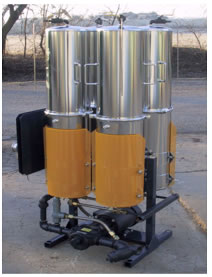Quench Oil Filtration Systems

Why filter your quench oils? As metal is quenched in an oil bath, fines form in the quench oil from the cooling process. Particles including carbon particles and tiny bits of flash are added to the quench oil over time. As these fines build up in the surrounding quench fluids, they can affect the quench in any number of ways.
The heat transfer characteristics of the carbon, flash, and other fines in the quench oil are all quite different from the surrounding quench fluid. As these fines increase in population in the surrounding quench fluid, the heat transfer rate of the bath also changes. And there is no guarantee the quench speed will be uniform across the quench bath, as compared to virgin quench fluids.
This results in localized differences in heat transfer on the parts in the bath. As a result of this inconsistent heat transfer, localized hardness can differ on the same part, or parts may even warp depending on size and shape. Additionally, parts can be stained or contaminated with particulate after the quench process, increasing the need for a better (read-more expensive) processes downstream to clean the parts.
Quench filtration will remove contamination and help maintain the quench speeds and cooling rates of the quench oil. Additionally, filtration can greatly improve the quality of the heat-treating process, reduce the number of rejected parts, and save money by extending the life of quench oils.
Let our quench oil experts help you incorporate a quench filtration system into your operation to maximize your company’s efficiency, quality and profitability. Call 800-453-8639 for more information.
| Quench Systems |
For System Volumes, Gallons |
Housings |
Heat Shields |
Pump, GPM |
Pump Type |
| Model C-265/5QH | < 1000 | (2) C-1000 CP | 2 | 5 | Hatrid |
| Model C-465/10QH | > 1000 | (4) C-1000 CP | 4 | 10 | Hatrid |
Typical Features - Quench Free Standing Filter System
- C-1000CP Chrome Plated Filter Housing w/Element Lifter
- Positive Displacement Gear Pump
- High Temperature External Pressure Relief Valve
- 1 Ph 115 V 1725 RPM TEFC Motor
- Motor Starter w/thermal Overload Protection
- On/Off Switch
- 0-100 Pressure Gauge to Monitor Element Loading
- 3/4 in NPT Inlet Wye Strainer
- Heavy-Duty Powder-coated Frame with Heat Shield

